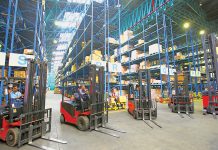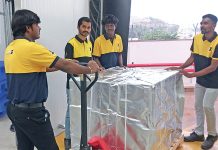CARGOTALK in collaboration with Cargo Service Centre (CSC) conducted Pharma Talkathon Part II Digital Conclave on the ‘Need for world-class cold chain Infrastructure in India’ recently. The insightful webinar focused on various aspects of cold chain sector such as handling, transporting cold chain shipments, recent technological advancements, investments in improving infrastructure, especially for pharmaceuticals, the country developing the trade lane between Europe, and the USA for pharmaceuticals, the role of technology to maintain the integrity of temperature-sensitive shipments and a lot more. The key speakers included Tushar Jani, Group Chairman, Cargo Service Center (CSC), Satish Lakkaraju, Senior Vice President, Global Head, Air Freight & Pharma, WIZ Freight, Radar Ventures, and Rashmi Karnad, Manager, Climate Control Product, Pharma, Qatar Airways. The discussion was moderated by SanJeet, Chief Executive Officer, DDP Group. The webinar created a lot of impact and saw great participation from the stakeholders of the industry.
India has potential to become biggest e-commerce pharmacy
Tushar Jani, Group Chairman, Cargo Service Center
Is India ready to become pharmacy of the world?
We must become self-sufficient on raw materials, mainly on the APIs for which we are still dependent on China. I think there would be a revolution of sorts if we are able to reduce this dependency or cut it down completely. We are without doubt the largest pharma supplier globally, and the biggest opportunity for us will be from the e-commerce side. India has the potential to become the biggest e-commerce pharmacy. Our Indian pharma companies, be it Sun Pharma, Glenmark, Cipla, Dr. Reddy’s, among others, are delivering drugs around the world in just 20 minutes—that is the power we need to create in India in partnership with all the pharma companies. From a generic drug manufacturer and supplier perspective, at present, we have 20 per cent market share, and to reach the 40 per cent nothing can stop us. Our cost of production as compared to the other nations is low, our regulations are easy as compared to the other countries, and in terms of value chain and tremendous investments happening in the research for pharma and drugs—nothing can stop us.
India vs China projections
I think the reliability India offers, China can never offer that reliability, especially after COVID. We have started with a strong foundation that India can be reliable. The country has always been number one in value-addition when it comes to pharma, more than China. China has volumes in terms of goods or intermediaries, components, or raw materials, but when it comes to finished goods, we beat China. The only thing that we do not have is the scale that China has. Our country must match that scale. With the kind of developments happening in Indian market for pharmaceuticals, I think we will remain biggest pharmacy of the world.
Manufacturing and distribution
There is good amount of efficiency that is being brought into the domestic Indian pharma supply chain. We offer the lowest prices of medicines as compared to any other country in the world. We are the world’s largest laboratory. By using Artificial Intelligence and Machine Learning, we get the exact data of more than 1.2 billion people, but matching research to equal that would be fantastic. We have huge clinical data in the country, and we can use it to our advantage.
Technology intervention
At CSC terminals in Mumbai, we have invested heavily in technology to ease the workflow. We have pharmacists working in the terminal to educate the handlers about the consequences of handling shipments incorrectly. Our pharmacists at the terminal can differentiate between the different types of medicines. So, we have created that empathy. We have put sensors in all corners of the terminal so that they can provide information on the temperature required for shipments, directly to your mobile phones through Turant App. You can track, trace, and monitor your shipment, anytime, anywhere. Also with AI, customers get information about the shipments in advance. Even for where the shipment would get unloaded, if there is sufficient air, or if we need to increase the temperature of air-conditioner. We in the supply chain need to collaborate and work towards solving the inefficiencies.
Mindset of industry stakeholders needs to change
Satish Lakkaraju, Senior VP, Global Head, Air Freight & Pharma, WIZ Freight, Radar Ventures
India has world-class cold chain infra?
India has developed many pharma zones, which are not common and are not seen in other parts of the world. The terminal operators have invested heavily in developing infrastructure. The understanding of pharma is far superior in most airports in India than in airports in most developed countries. The airports in Delhi, Mumbai, Hyderabad, and Bengaluru have world-class infrastructure, but in the days to come, regional airports such as Ahmedabad and Goa will have great infrastructure too. In India, some airports are at an advantage because they started with a greenfield airport, but brownfield airports also need attention. We will be having new airports soon, and infrastructure in this regard is a priority. Awareness about the need for cool dollies has also increased in the country.
Bottlenecks
Today, India has resolved the bottlenecks in this field to some extent. Indian airports have great infrastructure to support the industry’s growth. Cargo loading and offloading happen quickly here. Indian customers are aware of the transport of pharmaceutical products, while airports need to be prepared. Awareness is increasing, Indian airports have sufficient space, and, moreover, they are GDP certified too.
Recent advancements and developments
IoT is one of the most advanced tech that has come into being lately. With technology, you can identify the reasons why cargo has been lying on the tarmac for a longer time than he one specified for the shipment. Tech will help you be proactive in your approach. One of the pain points that customers, shippers, and agencies face today is Corrective Action and Preventive Action (CAPA), which is still manual and takes data from multiple sources to accumulate and do multiple analysis. If we can integrate data with airports, then you are stimulating a larger and faster report. India has a first-mover advantage as all the technology companies are here. Global firms are coming up with live data. Today it is possible to get the data even from the middle of the sky, so customers get more visibility. Control towers are going to be established, even for the road trucking industry. The mindset of stakeholders in pharma needs to change. There are current challenges in this sector. Technology does not come cheap, skillset is expensive.
Skilled manpower
Pharmacists and skilled manpower are required for cargo in the industry. But when it comes to pharmaceutical handling, we need trained personnel who know about the drugs. Cold chain handling needs a skilled workforce, such as the IATA certifications for pharma and dangerous goods handling, there is also GDP certification required. We have active and passive operators in India. Today, all the world’s top operators want to be in India, but we have a shortage of staff to handle equipment, be it Csafe, Envirotainer, Va-Q-tec, SkyCell, or SoftBox, among others.
Uncontrolled tarmac timings a challenge for pharma
Rashmi Karnad, Manager, Climate Control Product, Pharma, Qatar Airways
India has world-class cold chain infra?
With a current value of around US$50 billion, while the Indian pharmaceutical industry ranks third in the world in terms of volume, India is the largest supplier of generic drugs globally and contributes as much as 60 per cent of international vaccines. India is also developing medical device manufacture, which will propel the country as a healthcare manufacturing hub in the next two decades. India has world-class cold chain infrastructure to store, handle, and transport pharma and other temperature-sensitive shipments major airports such as Delhi, Mumbai, Hyderabad, and Bengaluru.
Significant investments have been made for infrastructure and technological development. In addition, the past few years have witnessed tremendous advancement in freight forwarding and vaccines distribution. Considering the size of the country and its potential,
India needs more development in the cold chain storage and distribution sector. There is room for growth. Some of the regional airports need to be developed more to avoid the current bottlenecks and players need to look more deeply into multimodal transportation. More participation from the industry
is needed.
Technology to enhance supply chain resilience
Digitalization is a significant aspect of the supply chain industry, be it digitalization within infrastructure, upskilling resource, monitoring, visibility, and process automation. While the country is the pharmacy of the world, it is also the backbone of the global IT industry. When it comes to digitalization, the cargo industry has come a long way,
but has a lot more to achieve. India has the willingness, enterprise, resources, bright minds who can take the industry to another level.
We have 5G technology and a variety of apps to improve visibility and transparency of shipments. Today, visibility is vital, and healthcare customers require this for tracking and temperature monitoring. There are companies offering a variety of electronic monitoring devices for location, temperature, humidity, shock, tilt, pressure monitoring and several other parameters. Usage of electronic monitoring devices will lead to efficiency and product safety. The optimal benefit can be derived when all this information can be integrated and unified to benefit the end-user rather than silos. It is vital to have end-to-end data visibility as this will drive supply chain efficiency, product efficacy and integrity.
Challenges in loading/offloading pharma
Uncontrolled tarmac timings are one of the major challenges for air freight healthcare products globally. India to a certain extent has managed this well. Tarmac time is determined by factors such as size of an airport, scale of operations, type of aircraft, ground service equipment, distance between warehouse and aircraft parking bays, business of airports. These are not in the control of airlines or cargo warehouse operators.
Many airports are investing in cool dollies and reefer trucks. Airlines and ground handlers are also offering other modes of protection such as thermal covers.
All involved parties need to continue to collaborate this crucial area of air transport supply chain to increase investment as well as return on investments.














